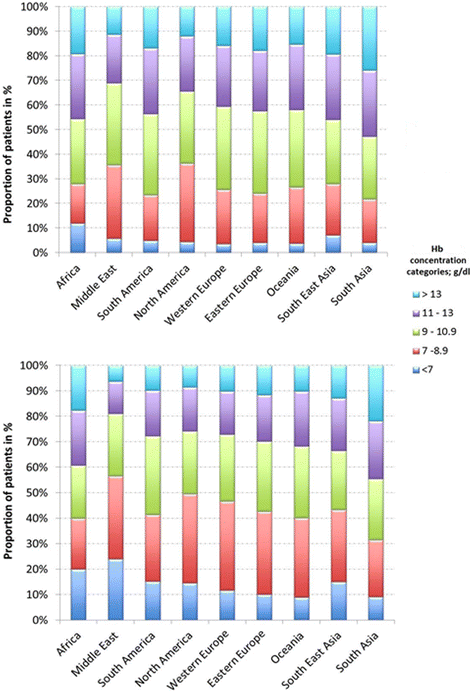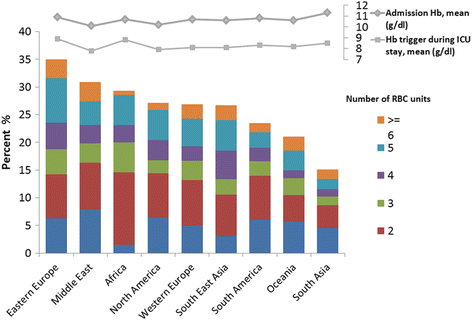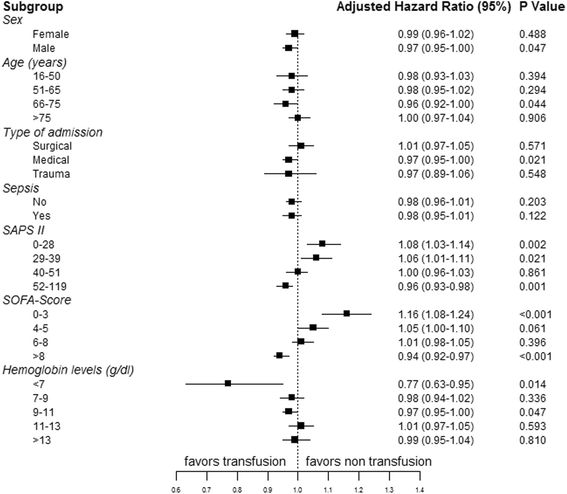Worldwide audit of blood transfusion practice in critically ill patients
- PMID: 29673409
- PMCID: PMC5909204
- DOI: 10.1186/s13054-018-2018-9
Worldwide audit of blood transfusion practice in critically ill patients
Abstract
Background: The aim was to describe transfusion practice in critically ill patients at an international level and evaluate the effects of red blood cell (RBC) transfusion on outcomes in these patients.
Methods: This was a pre-planned sub-study of the Intensive Care Over Nations audit, which involved 730 ICUs in 84 countries and included all adult patients admitted between 8 May and 18 May 2012, except admissions for routine postoperative surveillance.
Results: ICU and hospital outcomes were recorded. Among the 10,069 patients included in the audit, data related to transfusion had been completed for 9553 (mean age 60 ± 18 years, 60% male); 2511 (26.3%) of these had received a transfusion, with considerable variation among geographic regions. The mean lowest hemoglobin on the day of transfusion was 8.3 ± 1.7 g/dL, but varied from 7.8 ± 1.4 g/dL in the Middle East to 8.9 ± 1.9 g/dL in Eastern Europe. Hospital mortality rates were higher in transfused than in non-transfused patients (30.0% vs. 19.6%, p < 0.001) and increased with increasing numbers of transfused units. In an extended Cox proportional hazard analysis, the relative risk of in-hospital death was slightly lower after transfusion in the whole cohort (hazard ratio 0.98, confidence interval 0.96-1.00, p = 0.048). There was a stepwise decrease in the hazard ratio for mortality after transfusion with increasing admission severity scores.
Conclusions: More than one fourth of critically ill patients are transfused during their ICU stay, with considerable variations in transfusion practice among geographic regions. After adjustment for confounders, RBC transfusions were associated with a slightly lower relative risk of in-hospital death, especially in the most severely ill patients, highlighting the importance of taking the severity of illness into account when making transfusion decisions.
Keywords: Red blood cell; Severity of illness; Worldwide.
Conflict of interest statement
Ethics approval and consent to participate
Institutional review board approval for ICON was obtained by the participating institutions according to local ethical regulations.
Competing interests
JLV is Editor-in-Chief of Critical Care. The other authors have no conflicts of interest to declare related to this article.
Publisher’s Note
Springer Nature remains neutral with regard to jurisdictional claims in published maps and institutional affiliations.
Figures



References
-
- Docherty AB, O'Donnell R, Brunskill S, Trivella M, Doree C, Holst L, et al. Effect of restrictive versus liberal transfusion strategies on outcomes in patients with cardiovascular disease in a non-cardiac surgery setting: systematic review and meta-analysis. BMJ. 2016;352:i1351. doi: 10.1136/bmj.i1351. - DOI - PMC - PubMed
MeSH terms
Substances
LinkOut - more resources
Full Text Sources
Other Literature Sources
Medical

